Beauty
Why Auricle Piercings Are Perfect For Curated Constellations
Your guide to the cartilage placement.
One of the coolest trends to emerge in the past decade is without a doubt curated ear constellations. Whether your stack is pre-planned with the help of a professional or pierced piecemeal over several years, the end result is always the same: a totally customized collection of ear jewelry that adds so much elegance and edge to your look. Once you’ve decided to go all-in on the more-is-more trend, all that’s left is picking where to start. An auricle piercing just so happens to be a perfect placement for your ear jewelry — and despite its unusual name, the piercing is actually one you’re already familiar with.
As it happens, an auricle piercing is just another name for a helix piercing (itself also routinely referred to as “cartilage piercings” as a catch-all) that’s located about halfway down your outer ear ridge. And since having so many distinct, harmonious piercings in one ear is so popular, it’s increasingly necessary to get specific — hence the auricle’s ultra-precise definition. But even with the fancy name, the actual procedure for this particular spot is a pretty simple one. To lend an inside look at the entire process, Bustle turned to Brian Keith Thompson, celebrity piercer and owner of Los Angeles’ legendary Body Electric Studio. Below, your complete guide to auricle piercings, with some save-worthy inspo along the way.
What Is An Auricle Piercing?
Essentially, an auricle piercing is simply a helix piercing positioned halfway down the ear. A popular location to host a delicate stud, hoop, or chain, the right auricle piercing jewelry can make all the difference for a curated ear. But because the term is relatively new, be sure to discuss the desired placement with your piercer before any needles come out. “A lot of times, people start calling piercings things that we [professional piercers] don't,” Thompson explains. “Like a Monroe, for example — I just call it a lip piercing.” To make sure you’re both on the same page, take some time to plan out your vision and talk it over with your piercer — they’re the pros, after all.
What Should You Expect?
The auricle’s location is one of the more accessible ear piercing placements, so if you have your heart set on a hoop, it may be a possibility. However, experts note that studs are always the safest, easiest choice for avoiding snags, irritation, and other interference that might prolong the healing process.
The price of an auricle piercing depends largely on the type of jewelry you ultimately choose. Usually, the piercing service itself is a flat rate set by the studio (typically around $30-70 for standard services, more if you seek out more advanced experts), with the stud or ring an additional cost.
What Is Aftercare Like?
Thompson explains that because cartilage is a dense tissue, the complete healing process can take between six months to a full year. The thick tissue means your body needs longer to repair the fistula (the tiny tunnel building around the jewelry), he says, and it’s a process that can be deceptive. “Piercings heal from the outside in,” Thompson explains, so it’s easy to think things are further along than they actually are. Even if it looks totally fine on the outside, he says it’s still healing internally.
Translation? It’s important to keep up with your aftercare practices to avoid regression. Thompson recommends using a gentle face-friendly wash like CeraVe, ending a myth that post-piercing washes should be strictly antibacterial. “I like to incorporate a saline solution into it, too,” Thompson says, adding that you can use a misting version as often as desired. As long as you keep the area clean and away from friction or tugging, your curated ear should be as good as gold — all you’ll have to do is plot the next piercing for your stack.
